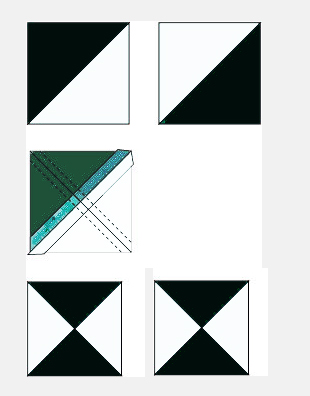Make a Batch of Quarter Square Triangle Units
Quarter square triangle units can be assembled by sewing four triangles together to make the patchwork shown below, but it’s much faster, easier, and more accurate to assemble them with a quick piecing technique that uses half square triangle units as their ‘parents.’
Grab seven of the 5-1/4″ x 5-1/4″ squares labeled A3 and cut seven B squares of the same size. Set aside the extra 5-1/4″ A3 squares.
Ignore the lighter color in the middle drawing — it represents the dark fabric’s back and is hopefully light enough to make lines visible.
Quarter square triangle units can be chain pieced as explained on the previous page but it’s best to sew just one set first to make sure you don’t need to adjust your seam allowance.
- Draw a diagonal line from one corner to the opposite corner of a B square.
- Align the squares, right sides together. Secure with straight pins.
- Sew a scant 1/4″ seam allowance on each side of the center line as explained in the Option 1 half square triangle method on page 1 cutting instructions.
- Cut apart on the drawn line and press towards the dark fabric to create two half square triangle units that measure 4-7/8″ x 4-7/8″.
- If your units are too small, press again and use a slightly narrower seam allowance for remaining steps on this page. It’s more common for patchwork to be too small than too large, but always check dimensions as you work and adjust seams as necessary.
- Draw a diagonal line from corner to corner on one of the units — it should cross over the original seam as shown above center.
- Align two units right sides together placing units so that contrasting fabrics touch each other. The seam allowances of the units should butt together for a perfect fit.
- Sew two more seams, each 1/4″ (or your adjusted seam width) from the new line.
- Press to set the seams and then cut through all layers on the new drawn line. Press open.
- You should have two A / B quarter square triangle units that measure 4-1/2″ x 4-1/2″.
- Repeat to combine the remaining pairs of six contrasting squares, making a total of 14 units. One won’t be used.





